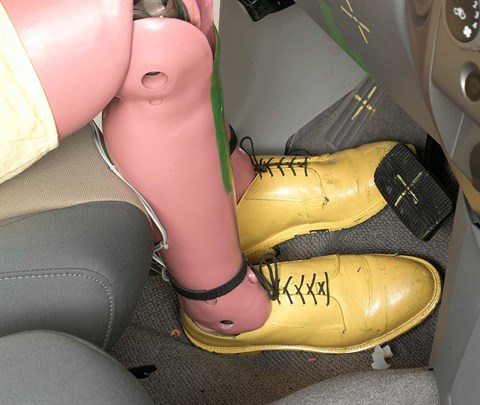Moderate overlap front: original test
Rating applies to 2004-12 models
Tested vehicle: 2004 Nissan Titan XE King Cab 2WD pickup
The Nissan Titan was introduced in the 2004 model year.
| Evaluation criteria | Rating |
|---|---|
| Overall evaluation | |
| Structure and safety cage | |
| Driver injury measures | |
| Head/neck | |
| Chest | |
| Leg/foot, left | |
| Leg/foot, right | |
| Driver restraints and dummy kinematics | |

Action shot taken during the frontal offset crash test.

The dummy's position in relation to the steering wheel and instrument panel after the crash test indicates that the driver's survival space was maintained well.

The dummy's head bottomed out the airbag and hit the steering wheel underneath. Head acceleration from this hit was high.

Forces on both legs and feet were low, indicating that significant injury was unlikely.
Side: original test
Rating applies to 2004-09 models
Tested vehicle: 2009 Nissan Titan SE Crew Cab 4x2 with optional front and rear head curtain airbags and optional front seat-mounted torso airbags
The Nissan Titan was introduced in the 2004 model year. Two tests of a 2009 Titan were conducted, one with optional side airbags for the driver and rear passenger, and one without. These vehicles are rated separately, except that the structural ratings for both vehicles are based on both tests. Beginning with 2010 models, the side airbags were made standard.
| Evaluation criteria | Rating |
|---|---|
| Overall evaluation | |
| Structure and safety cage | |
| Driver injury measures | |
| Head/neck | |
| Torso | |
| Pelvis/leg | |
| Driver head protection | |
| Rear passenger injury measures | |
| Head/neck | |
| Torso | |
| Pelvis/leg | |
| Rear passenger head protection The side curtain airbag did not cover the entire window opening during deployment, and the dummy's head continued to move outward after it was contacted by the side airbag. Although the intruding barrier did not hit the dummy's head in this test, the head was not protected from contacts outside the vehicle. | |

View of the vehicle and barrier just after the crash test.

View of the vehicle after the crash with doors removed, showing the side airbags and damage to the occupant compartment.

Smeared greasepaint shows where the driver dummy's head was protected from being hit by hard structures by the side airbags.

Because the side curtain airbag did not fully cover the window opening, the dummy's head continued to move outward during the crash.
Rating applies to 2004-09 models
Tested vehicle: 2009 Nissan Titan SE Crew Cab 4x2 without optional side airbags
The Nissan Titan was introduced in the 2004 model year. Two tests of a 2009 Titan were conducted, one with optional side airbags for the driver and rear passenger, and one without. These vehicles are rated separately, except that the structural ratings for both vehicles are based on both tests. Beginning with 2010 models, the side airbags were made standard.
| Evaluation criteria | Rating |
|---|---|
| Overall evaluation | |
| Structure and safety cage | |
| Driver injury measures | |
| Head/neck | |
| Torso | |
| Pelvis/leg | |
| Driver head protection Although the intruding barrier did not hit the dummy's head in this test, the head was not protected from contacts outside the vehicle. This indicates that only slightly different crash circumstances could produce a direct hit to a person's head. | |
| Rear passenger injury measures | |
| Head/neck | |
| Torso | |
| Pelvis/leg | |
| Rear passenger head protection Although the intruding barrier did not hit the dummy's head in this test, the head was not protected from contacts outside the vehicle. This indicates that only slightly different crash circumstances could produce a direct hit to a person's head. | |

View of the vehicle and barrier just after the crash test.

View of the vehicle after the crash with doors removed, showing the damage to the occupant compartment.

Action shot taken during the side impact crash test showing the driver dummy's head leaning well outward and approaching the window sill.

Intrusion of the B-pillar and door sill into the occupant compartment is apparent in this view.
Roof strength
Rating applies to 2004-15 models
Tested vehicle: 2011 Nissan Titan Crew Cab
Rating applies to Crew Cab models, except for 4wd Crew Cab long bed model. Rating of this model is Marginal.
| Overall evaluation | |
|---|---|
| Curb weight | 5,008 lbs |
| Peak force | 17,847 lbs |
| Strength-to-weight ratio | 3.56 |
Head restraints & seats
Seat type: All seats AHR
| Overall evaluation | |
|---|---|
| Dynamic rating | |
| Seat/head restraint geometry |
About the head restraint & seat test
Currently, IIHS tests apply only to front seats.
